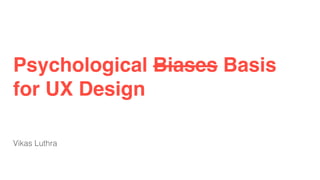
Psycholigcal basis for ux design
- 1. Psychological Biases Basis for UX Design Vikas Luthra
- 3. 17 × 24
- 6. Complete the phrase “bread and…” Make a “disgust face” when shown a horrible picture. Answer to 2 + 2 = ? Complete the phrase “bread, dustbin and…” Focus on the voice of a particular person in a crowded and noisy-room. Look for a woman with white hair. Maintain a faster walking speed than is natural for you. Example Activities that are attributed to System 1: Example Activities that are attributed to System 2:
- 7. For each columns say in your mind the position of words: whether left or right ? Column 1 Column 2
- 8. We tend to perceive things what we expect and familiar with Our perception is biased by our: • Our experience • The context • Our goal. We Create Mental Models
- 9. Salience
- 10. We perceive for structure and patterns
- 11. F-Pattern
- 12. Z-Pattern
- 13. We don't want to work or think more than we have to. Our System 2 is lazy… • Least amount of cognitive load and mental effort • Majority of us can’t multi-task. • Want cognitive ease and flow state • Not to be overwhelmed with information. Allowing Information scanning.
- 14. We Don't Want to Work or Think More than we have To. • Progressive disclosure: Show a little bit of information and let them choose if they want more details • Show people an example. • Defaults let people do less work to get the job done • Design for Simplicity : Features that people really need. Minimalism not equal to simplicity Progressive disclosure to show information step by step
- 15. Cognitive Ease
- 16. Progressive Disclosure: Details only when provided
- 17. Progressive Disclosure: Duo-lingo interactive way of how app works.
- 18. Progressive Disclosure: Instructional Overlays.
- 19. Our Attention is limited • Attention is a key to designing an engaging UI. You can use the senses to grab attention. Bright colors, large fonts, beeps, and tones will capture attention. • Number( Hicks’ law) and Size (Fitts’s Law) of objects affects our decision making process. Tunnel Vision and Change Blindness • Peripheral vision is poor, and visual search is linear unless target “pops” in periphery. • We are more goal focused and miss items in our views.
- 23. Hick’s Law Hick’s Law describes that the time it takes for a person to make a decision depends on the choices available to him or her. So if the number of choices increases, the time to make a decision increases logarithmically.
- 24. People are programmed to pay attention to anything that is different or novel. If you make something different it will stand out. “When multiple similar objects are present, the one that differs from the rest is most likely to be remembered!” Von Restorff Effect
- 27. We are Social • Social validation and support. People look to others for guidance on what they should do •Synchronicity: If people do something together at the same time (synchronous behavior) it bonds them together—there are actually chemical reactions in the brain. Laughter also bonds people. •Reciprocity: If you do a favor for me then I will feel indebted to give you a favor back (reciprocity). Research shows that if you want people to fill out a form, give them something they want and then ask for them to fill out the form, not vice versa. .
- 28. Reciprocation
- 29. Reciprocation
- 31. We make unconscious and irrational decisions • Commitment Bias: Commit to a small action then more likely later commit to a larger action. • Framing: People react to a particular choice in different ways depending on how it is presented. • Anchoring Effect: An anchor is a thing that serves as a reference point for our comparisons. • Ordering Effect: Ordering of things influence our choices • Loss Aversion: We rate our losses higher than our gains
- 33. Use of Framing
- 34. Scarcity Negative Framing + Loss Aversion
- 36. Serial position effect The Serial Position Effect is the propensity of a user to best remember the first and last items in a series. Most Important information of a website in front and the end.
- 37. Lastly, We crave for information and visceral rewards • Want more information than they can actually process. Having more information is more choices and makes people feel in control and they could survive better. • People need feedback. The human needs to know what is going on. Power of 10 • We are looking for visceral rewards and perform certain behavior regularly leading to habit formation.
- 38. Trigger that starts the behaviors: Physical, or mental. (thought, emotion) The action taken by us (thought, emotion) The benefit you gain from doing the habit. Habit Formation Loop Micro Interactions as Triggers
- 39. Habit forming UX
- 41. Cognition • Attention is limited; Memory is imperfect. • We need social support and validations • We do not want to think a lot. • We crave for more information and visceral rewards • We make unconscious decisions which could be irrational • We have mental models and shortcuts Perception • Perception is biased by experience, context, goals • Our vision is optimized to perceive structure (Gestalt principles).We seek and use structure • Our peripheral vision is poor, and visual search is linear unless target “pops” in periphery. To summarize,
- 44. • Designing with the Mind in Mind by Jeff Johnson • 100 Things Every Designer Needs to Know About People by Susan Weinschenk • The Design of Everyday Things by Don Norman (first title: The Psychology of Everyday Things) • Influence: The Psychology of Persuasion by Robert Cialdini • Thinking Fast and Slow by Daniel Kahneman • Flow: The Psychology of Optimal Experience by Mihaly Csikszentmihalyi Reading Resources
